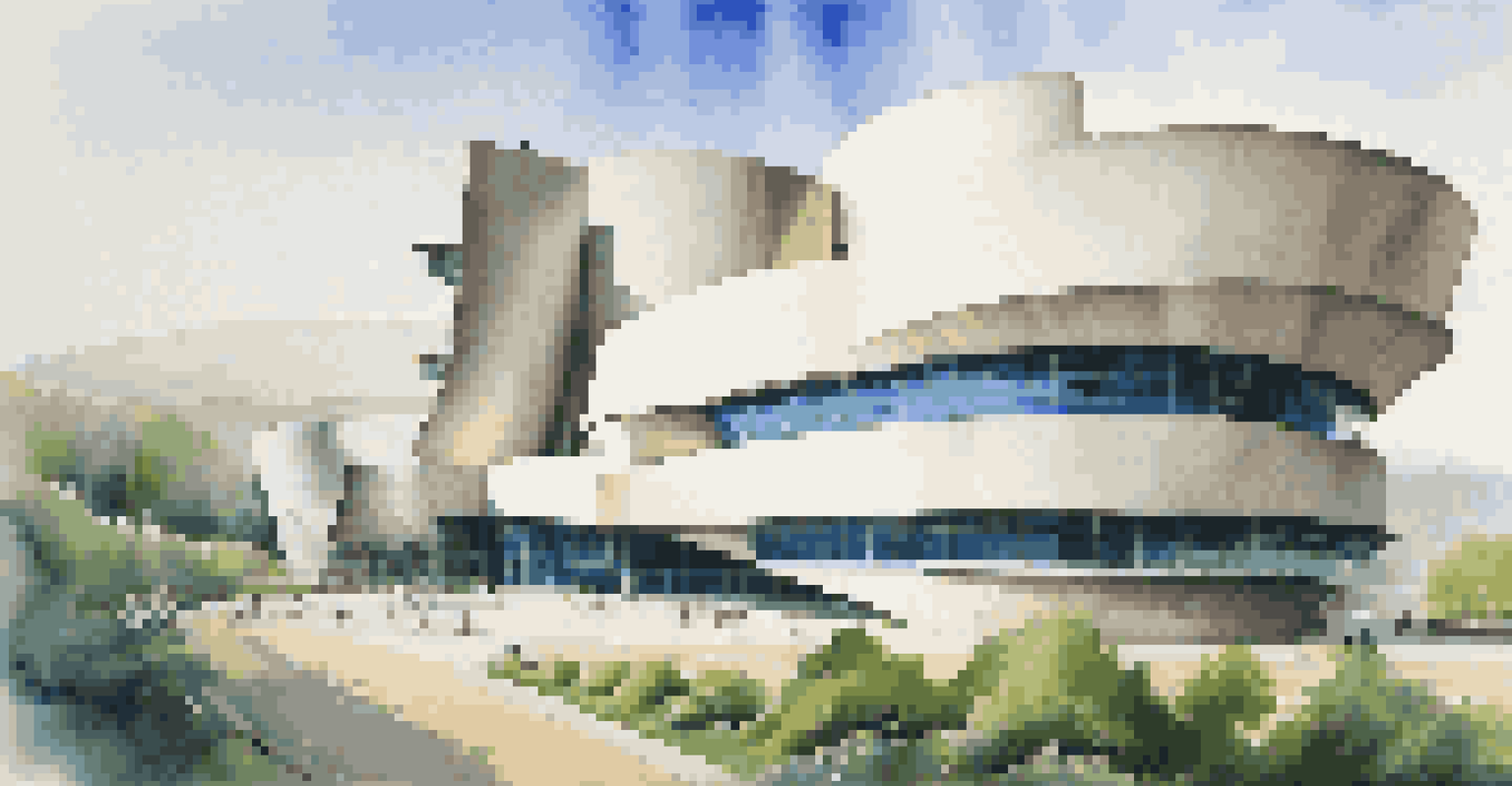The Concept of the Sublime in Art: Historical and Modern Perspectives

Understanding the Sublime: A Definition
The sublime is a complex aesthetic concept that evokes feelings of awe and wonder. Originating from ancient philosophy, it describes experiences that transcend ordinary beauty, often stirring deep emotional responses. Think of standing before a majestic mountain range or gazing at a vast ocean; these moments can leave us feeling both insignificant and profoundly connected to something greater.
The sublime is not a product of the senses but of the mind, and it is through the mind that we access the infinite.
Historically, the sublime was closely linked to nature, particularly in the Romantic era, where artists sought to evoke feelings of grandeur and emotional intensity. This was a departure from the classical ideals of beauty that emphasized harmony and proportion. Instead, the sublime embraced chaos and power, urging viewers to confront their own limitations and the vastness of the world around them.
In modern discussions, the sublime continues to evolve, encompassing not just natural landscapes but also man-made structures and contemporary art. The notion of the sublime has expanded to include experiences that challenge our perceptions and push boundaries, allowing for a richer understanding of what can evoke awe in today's world.
Historical Perspectives: The Sublime in the 18th Century
The 18th century marked a significant turning point in the appreciation of the sublime, particularly through the writings of Edmund Burke and Immanuel Kant. Burke’s essay 'A Philosophical Enquiry into the Origin of Our Ideas of the Sublime and Beautiful' argued that the sublime arises from feelings of terror and vastness, pushing the boundaries of conventional beauty. This idea resonated with artists and thinkers of the time, influencing their work profoundly.

Kant, on the other hand, approached the sublime from a philosophical standpoint, suggesting that it represents an encounter with the limits of our understanding. He distinguished between the mathematical sublime, which relates to vastness and infinity, and the dynamic sublime, connected to overwhelming forces like storms or earthquakes. This philosophical exploration laid the groundwork for how artists would interpret and depict the sublime in their works.
The Sublime Evokes Awe and Wonder
The sublime is an aesthetic concept that transcends ordinary beauty, inspiring deep emotional responses and a sense of connection to something greater.
Artists like Caspar David Friedrich and J.M.W. Turner captured these ideas beautifully, using dramatic landscapes and tumultuous skies to evoke the sublime. Their works invited viewers to engage with nature's grandeur, reflecting the emotional depth associated with the sublime and echoing the philosophical debates of their time.
Romanticism and the Rise of the Sublime
Romanticism, which emerged in the late 18th and early 19th centuries, celebrated the sublime as a key element of artistic expression. Artists sought to evoke powerful emotions and confront the sublime through dramatic landscapes and evocative themes. The movement emphasized individual experience and the emotional response to nature's grandeur, often depicting storms, mountains, and vast oceans.
There is a kind of beauty in imperfection.
Figures like Turner and Friedrich exemplified this approach, using light and color to create dynamic compositions that resonated with the viewer's sense of wonder. For instance, Turner's 'The Fighting Temeraire' captures the sublime by juxtaposing the majestic ship against a dramatic sunset, evoking feelings of nostalgia and awe. This interplay between nature and human experience became a hallmark of Romantic art.
The Romantic embrace of the sublime also extended to literature and music, with poets like William Wordsworth and composers like Ludwig van Beethoven exploring similar themes. This interconnectedness across artistic disciplines enriched the concept of the sublime, allowing it to flourish as a defining characteristic of the Romantic era.
The Sublime in 19th-Century Art Movements
As the 19th century progressed, various art movements began to reinterpret the sublime in unique ways. The advent of Realism and Impressionism brought a shift in focus from grand landscapes to everyday scenes, yet the sublime remained relevant. Artists like Claude Monet captured the beauty of nature in a way that still evoked awe, using light and color to create immersive experiences.
In contrast, the Symbolist movement embraced the sublime as a means of expressing deeper emotions and metaphysical concepts. Artists like Gustave Moreau and Odilon Redon used dreamlike imagery and mythological themes to evoke feelings of mystery and wonder. Their works often blurred the line between reality and imagination, reflecting the complexity of the sublime experience.
Historical Evolution of the Sublime
From the 18th century's philosophical discussions to Romanticism's artistic expressions, the sublime has continuously evolved, reflecting changing perceptions of beauty and nature.
This evolution of the sublime in the 19th century demonstrated its adaptability, allowing artists to explore new subjects while maintaining a sense of awe and emotional resonance. The discussions around the sublime continued to influence various artistic expressions, paving the way for future explorations in the 20th century.
Modern Interpretations: The Sublime in Contemporary Art
In the 20th and 21st centuries, the concept of the sublime has seen a revival in contemporary art, often reflecting the complexities of modern life. Artists like Anselm Kiefer and Olafur Eliasson have explored the sublime through large-scale installations that engage with themes of nature, memory, and human existence. Their works challenge viewers to confront their own emotional responses and the realities of the world around them.
The sublime is also prevalent in modern architecture, where structures like the Guggenheim Museum in Bilbao and the Burj Khalifa evoke feelings of awe through their sheer scale and innovative design. These buildings not only serve functional purposes but also aim to inspire wonder and contemplation, reflecting the enduring power of the sublime in contemporary society.
Moreover, the digital age has introduced new dimensions to the sublime, with artists using technology to create immersive experiences that evoke awe. Virtual reality installations and digital art can transport viewers to otherworldly experiences, expanding the boundaries of how we understand and engage with the sublime in our increasingly complex world.
The Sublime and Nature: An Ongoing Relationship
Throughout history, the sublime has maintained a strong connection to nature, serving as a reminder of its power and beauty. Even in the digital age, artists continue to draw inspiration from the natural world, capturing its grandeur and complexity. This ongoing relationship speaks to our innate desire to connect with nature and the emotional responses it can evoke.
Contemporary environmental art, for instance, often seeks to highlight the sublime aspects of nature while addressing pressing issues like climate change. Artists like Chris Jordan and Maya Lin create works that provoke reflection on humanity's impact on the environment, evoking feelings of both awe and urgency. This intersection of art and environmentalism illustrates how the sublime remains relevant in our modern context.
Contemporary Reinterpretations
In modern art and architecture, the sublime remains relevant, challenging viewers to confront their emotional responses and engage with the complexities of contemporary life.
In this way, the sublime serves as a bridge between the past and present, allowing us to explore our emotional connection to the natural world. It invites us to reflect on our place within the universe and the beauty that surrounds us, reminding us of the power and significance of nature in our lives.
Conclusion: The Enduring Power of the Sublime
The concept of the sublime has evolved significantly over the centuries, transcending different art movements and philosophies. From its roots in ancient thought to its modern interpretations, the sublime continues to inspire artists and captivate audiences. It serves as a powerful reminder of the emotions that art can evoke, encouraging us to confront our feelings of awe and wonder.
As we navigate an increasingly complex world, the sublime remains relevant, offering a space for reflection and connection. Whether through traditional landscapes, contemporary installations, or digital experiences, the sublime allows us to engage with our surroundings on a deeper level. It invites us to appreciate the beauty and power of both nature and human creativity.

Ultimately, the enduring power of the sublime lies in its ability to evoke profound emotions and challenge our perceptions. As we continue to explore and reinterpret this concept, we embrace the richness of human experience and the timeless quest for meaning in art and life.